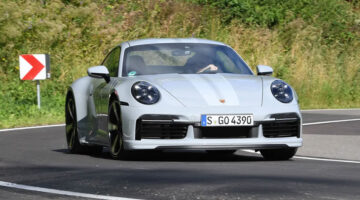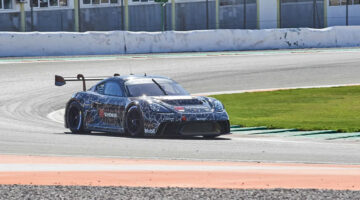It chewed up and spat out the McLaren 675LT and Ferrari 488 GTB, but still we reckoned the Porsche Cayman GT4 lacked bite. The setting was a dimly lit hotel bar in the far north of Scotland, and as the eight judges cast their votes after a solid week of back-to-back testing in the Highlands, it soon became clear Porsche’s sublime mid-engined coupe had pulled off something of a giant-killing act. It had even taken care of its faster, more illustrious brother, the 911 GT3 RS.
The hardcore Cayman won evo Car of the Year in 2015 for good reason. Each one of us emerged from the GT4 on more than one occasion shaking our head in disbelief, muttering incoherently about body control or steering precision. Its chassis was shot through with such quality that not even the latest from McLaren or Ferrari, cars costing three of four times as much, could get the better of it. But once we had all stopped spewing praise and affection upon the thing, we did all have one small criticism to make. The GT4’s drivetrain could use just a little more… snap.
California-based SharkWerks has been modifying 911s for more than a decade. In recent years the company has become recognised for its big-power GT3 engine conversions, but here it has turned its attention to the Cayman.

‘This is our interpretation of what a Cayman GT4 RS might be like,’ says founder Alex Ross. ‘Look at the differences between a 911 GT3 and a GT3 RS – lighter flywheel, more aero and more power. That’s exactly what we’ve done to the GT4.’
SharkWerks set out to rectify the car’s two main weaknesses: the 380bhp 911 Carrera S Powerkit engine, which lacks the intensity of a Porsche Motorsport unit, and the gearing, which is simply too long. The engine upgrades are limited to intake and exhaust systems for now, which liberate an additional 45bhp, but the company’s engineers are busy developing a 4.3-litre conversion with a custom billet crank, liners and bespoke pistons.
Adjusting the gear ratios wasn’t simply a case of reducing the final drive, or swapping out each of the cogs. In fact, it all proved to be fairly complicated. First and second are untouched, while third, fourth and fifth are now much shorter. Sixth can either be reduced or left alone. The first two ratios are on the main shaft and changing that would be fiendishly expensive, but Ross actually prefers those ratios being reasonably long because you can still comfortably use both in tight corners, particularly with the car’s auto-blip function.
In the standard GT4 you tend to use second and third gears on a typical flowing back road, and with third stretching to around 160kph there’s hardly any need to engage fourth. Now, says Ross, you generally use third and fourth, which means shifting forward and back in one plane rather than the slightly awkward third-to-second or second-to-third shift across two planes.
The Angeles Crest Highway wends through the picturesque San Gabriel Mountains to the north of Los Angeles, twisting and turning through sweetly cambered bends for 96 kilometres or so before dropping into the valley on the far side. It’s a magnificent stretch of road, and being within such easy reach of Downtown LA it draws countless car enthusiasts out of a city that has long been in love with driving. You see all sorts of performance machinery up here, plus countless everyday beaters and SUVs being driven on their door handles. We follow one expertly pedalled Hyundai saloon for mile after mile in the GT4, feeling no need whatsoever to find a way past.
Even the Highway Patrol seem to be in on it. Having heard us tearing along the road from several kilometres away before stopping to take some photos, one young police officer simply pulls up alongside us in his heaving Crown Vic, asks us to be sure to stick to our own side of the road, then tells us to go enjoy ourselves.

With the blessing of the locals, the weather and the law, the Angeles Crest Highway is the perfect place to put SharkWerks’ upgrades to the test. Parked in one of the many lay-bys along the road’s length, every one of them decorated with swirls of black tyre marks, this GT4 looks spectacular. The styling of the standard car is one of its many strengths, but with a higher rear wing, a small Gurney flap and those demonic, horn-like dive planes, it looks tougher than ever.
The new exhaust system, developed in collaboration with German tuning outfit Cargraphic, makes the car sound more purposeful than ever, too. In fact, the new exhaust finally gives the GT4 a soundtrack that befits a Porsche Motorsport product, with much more of the serrated, hard-edged howl of a GT3 or RS. The engine itself isn’t any more thrilling than the standard car’s, though, slightly sharper responses aside, and it still revs to just shy of 8000rpm rather than surging on towards 9000rpm. In the grand scheme of things, this 3.8-litre flat-six is a wonderful engine, but it’s roundly shown up by the more exotic units in hardcore 911s. We impatiently await SharkWerks’ 4.3-litre upgrade…
The revised gearing, meanwhile, does make a huge difference. The gearshift itself is one of the very best in the business, particularly with the switchable auto-blip function, and with second and third gears now so tightly stacked, there’s something brilliantly motorsport about that upshift, engine note barely changing as you slot third. It’s a little snapshot of a rally car’s close-ratio gearbox, and it never fails to raise a smile. In the hills above LA, third and fourth gears are perfectly spaced, so you press along, snapping forward and back between the two ratios, the more muscular engine burly enough to pull third gear away from the road’s tightest bends. The biggest difference between the standard car and this version is that you simply change gear more often. For a car that was sold on the interaction of its (delicious) manual transmission, that has to go down as a useful improvement.

SharkWerks hasn’t touched the GT4’s chassis – Ross says this is the first time he hasn’t felt the need to upgrade a single suspension component on a Porsche – but there is an uprated differential that’s more durable than the stock item. The transmission modifications, including gearing, LSD, flywheel and clutch kit, cost $15,000. The engine upgrades run to $6000, while the aero changes cost $2500.
These are not modest sums of money, but if there’s any subset of car enthusiasts who’ll find value in those upgrades it’ll be the Porsche Motorsport crowd. For a GT4 owner who wants their car to have more of the bite of the GT3 RS they almost certainly have parked alongside it in their garage, the SharkWerks upgrades are very well executed. Fitting that it should take a shark to give the Cayman its teeth.
This article originally appeared at evo.co.uk



